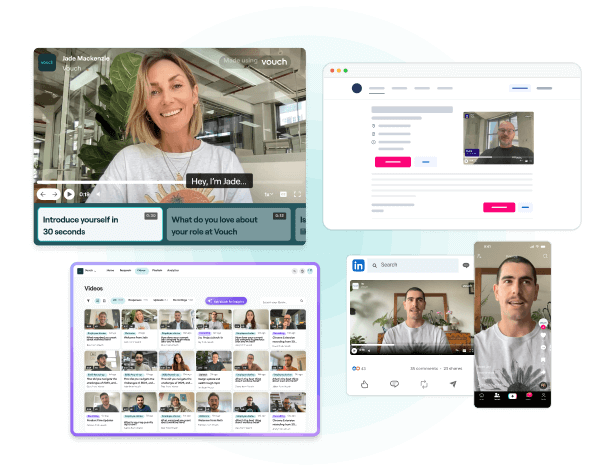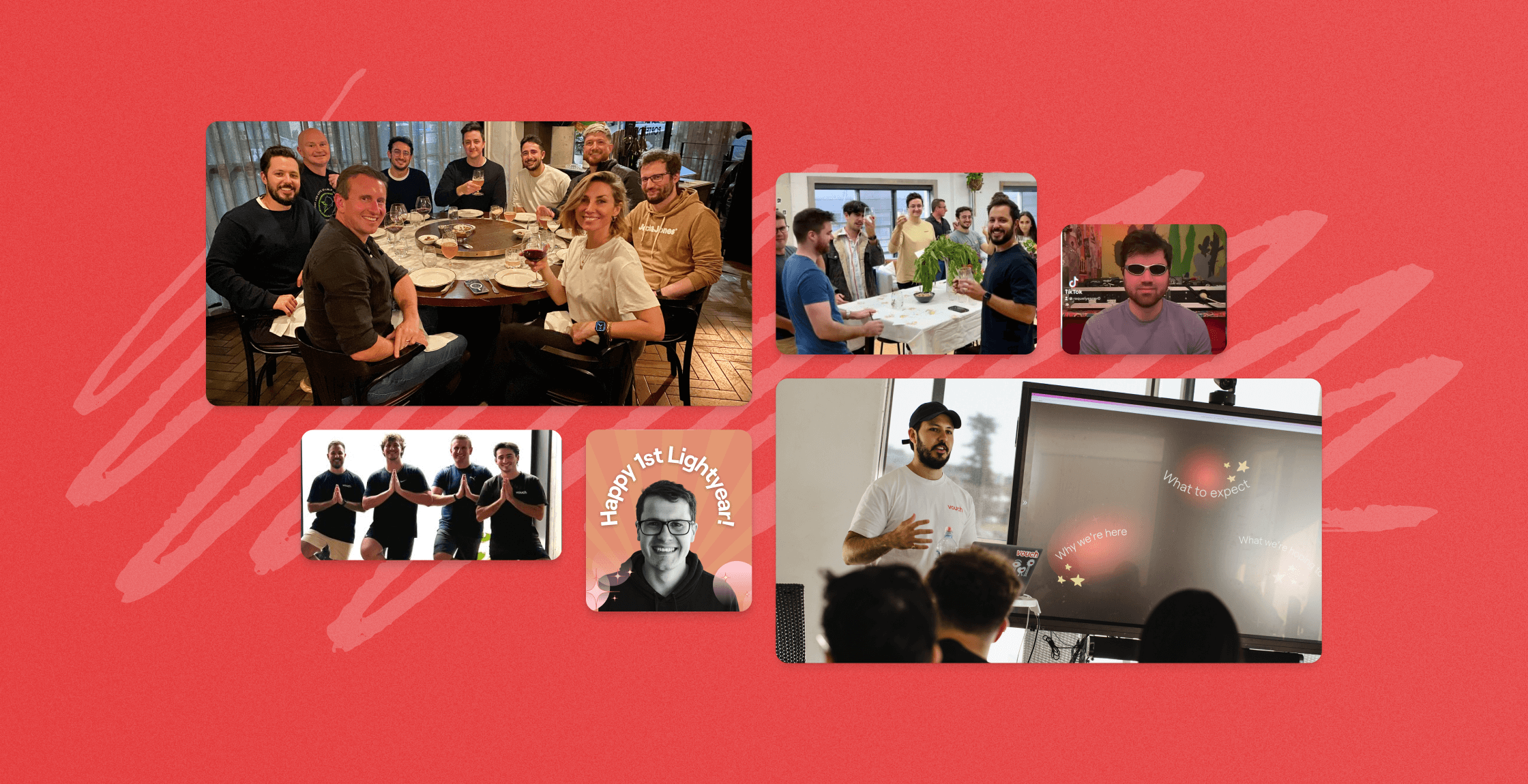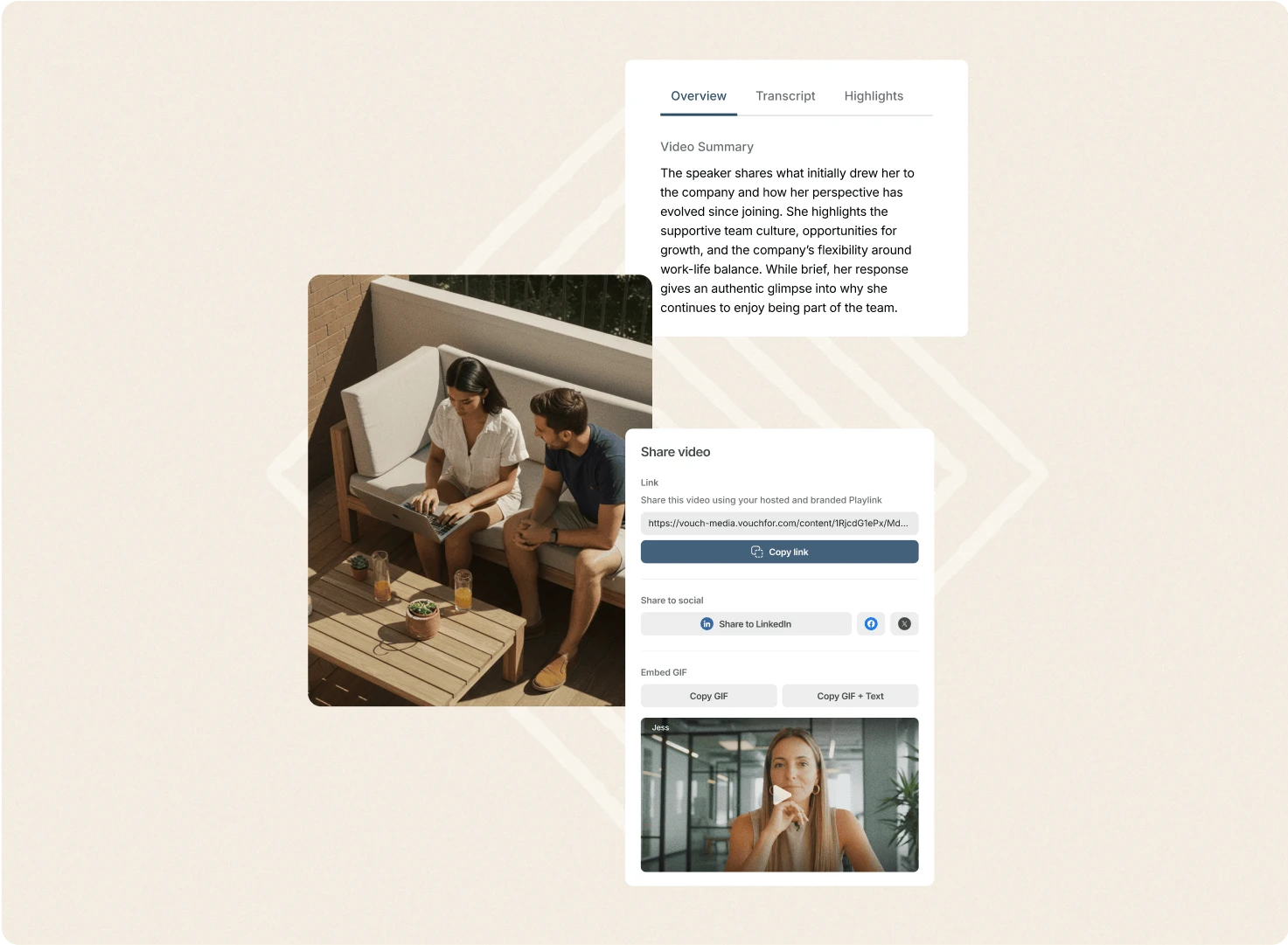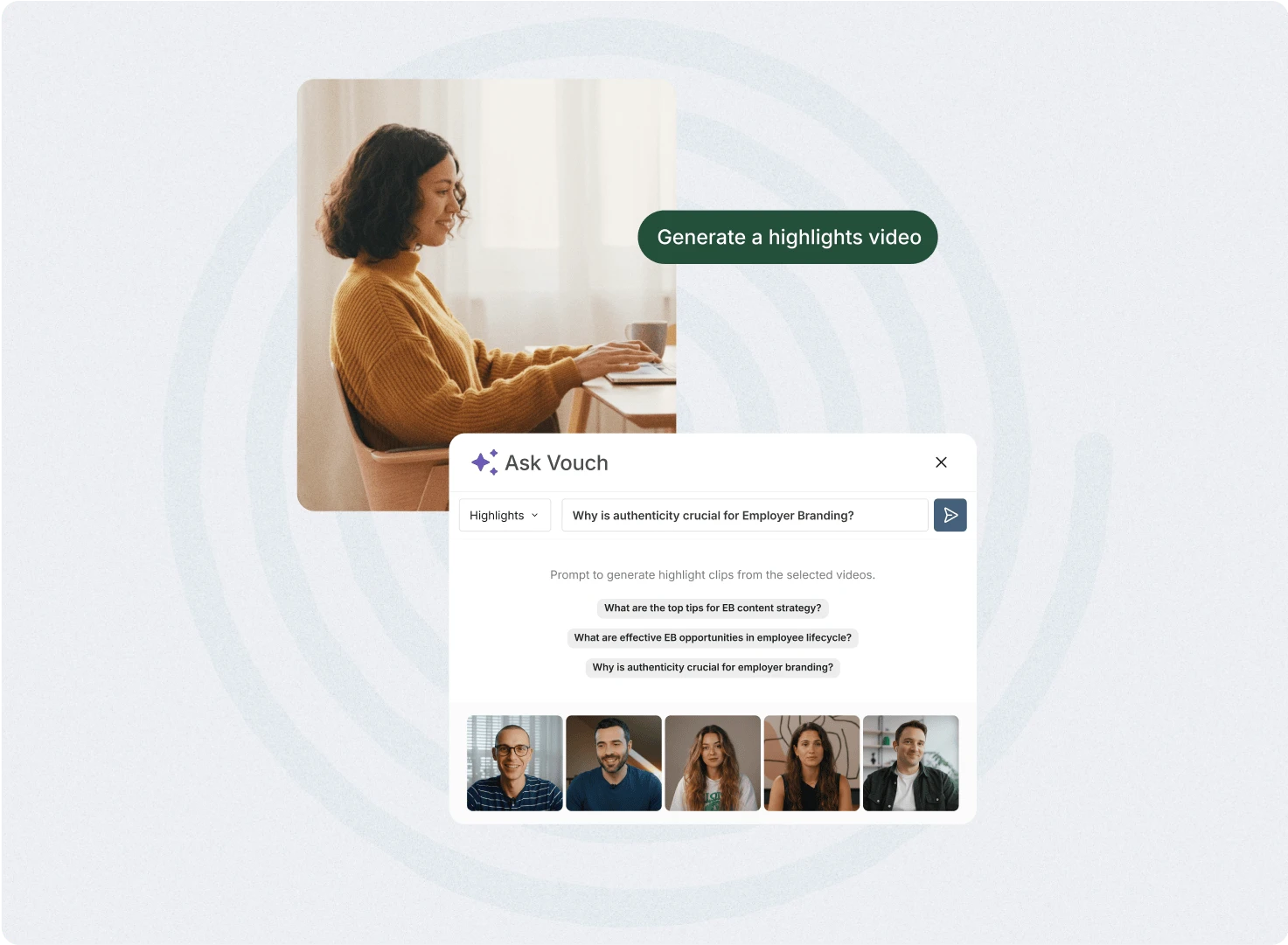Imagine looking for a job and scrolling through Glassdoor or Seek, trying to find the position that best fits your skills, values and culture.
You find two companies advertising similar jobs; one job listing only mentions the tasks and responsibilities, but not much else.
The other job post highlights a creative work environment, paths for career growth, and programs that focus on employee happiness - which job and company would you choose?
This example quickly shows how vital your employer brand is for attracting the best employees, and that is scratching the very surface!
If you're looking to learn more about your Employer Branding, you've come to the right place.
Let's get started.
Key Highlights:
- Your Employer brand is crucial for attracting top talent and creating a positive workplace environment.
- Your Employer brand can make recruitment more cost-effective while attracting higher quality talent.
- Modern tools like Vouch video are designed to help you grow your employee brand, including on social media platforms.
What Is Employer Brand, And Why's It So Important?
Your Employer Brand, at its core, is your company's unique personality.
It's the atmosphere your company has, the beliefs and tone of your company, and your company's vision & mission.
Here are a few reasons why your employer brand is so important:
- Become A Talent Magnet: A strong brand acts like a magnet, attracting high-quality candidates who align with your values and culture.
- More Cost-Effective Recruitment: By attracting the right talent, you can reduce recruitment costs and improve the efficiency of your hiring process.
- A Competitive Edge: In a crowded marketplace, a compelling employer brand sets you apart from competitors, making you the employee of choice.
- Boosted Morale and Productivity: A positive brand enhances employee morale and productivity, leading to a more engaged workforce.
- Enhanced Retention: Employees who are proud of their workplace are more likely to stay, reducing turnover and the associated costs.
- Better Customer Perception: Your workplace brand not only attracts top talent but also enhances customer perception, increasing loyalty and satisfaction.
- The Right Thing To Do: By engaging and highlighting your employees, you'll also be focusing on the things that matter most to them.
What Are Some Key Statistics on Employer Branding?
Employer brand statistics highlight the importance of employer branding strategy in talent acquisition and employee engagement.
1. According to Glassdoor, 92% of workers would consider switching positions even if there was no pay boost if the position was with a company with a good reputation
2. In a LinkedIn survey, 75% of job seekers consider an employer's brand before applying for a job.
3. Gallup's State of the Global Workplace report revealed that companies with highly engaged employees outperform their competitors by 147% in earnings per share.
The statistics go on:
- 72% of recruiting leaders around the world agree that employer branding has a significant impact on hiring. Source: TalentLyft
- Employees who understand and connect with their company's mission and values are 67% more engaged. Source: Gallup
- 89% of HR leaders agree that a strong employer brand gives them a competitive advantage in attracting top talent. Source: Randstad
Bring your employer brand to life
- Empower employees’ storytelling
- Transform careers sites with video
- AI-driven video editing
- Publish videos anywhere

What Are 5 Key Employer Branding Strategies?
Whether you're a seasoned HR professional or a business owner looking to enhance your company's reputation, the strategies below will help you craft a winning employer brand or reputation that resonates with potential candidates and sets your company apart from your competition.
1. Cultivate a Strong Employer Value Proposition (EVP)
Cultivating a strong employer value proposition (EVP) is essential for building an attractive company brand. Your EVP communicates the unique benefits and opportunities that your organization offers to employees.
To cultivate a strong EVP, start by clearly defining your company values and culture.
This involves identifying what sets your organization apart from competitors and articulating the critical aspects of your company's identity.
Next, showcase your EVP through various channels, such as your company website, social media platforms, and job postings. Highlight the benefits and opportunities that employees can expect, such as career development programs, work-life balance initiatives, and a supportive work environment.
Ensure that the values and messaging conveyed in your branding efforts are consistent with your overall brand identity.
2. Leverage Social Media to Enhance Employer Brand Visibility
Social media platforms are powerful tools for enhancing brand visibility. By leveraging social media effectively, you can reach a broad active and passive audience of potential candidates - while building brand awareness.
Start by creating and maintaining a solid presence on relevant social media platforms such as Facebook, Instagram, LinkedIn and Twitter. Use these platforms to showcase your company culture, values, and job opportunities. Regularly post engaging content that highlights employee stories, company achievements, and industry insights.
LinkedIn is particularly valuable for employer branding. Create a LinkedIn company page that reflects your brand and regularly shares updates and job opportunities. Encourage employees to engage with your social media content and share their experiences as brand advocates.
3. Implement Employee Advocacy Programs
Implementing employee advocacy programs can significantly enhance your employer brand. By encouraging employees to become brand advocates, you can amplify your brand message and attract like-minded individuals.
Employee advocacy programs involve empowering and incentivizing employees to share their positive experiences and success stories through various channels, such as social media, online reviews, and testimonials. Innovative software, such as the Vouch video platform, can help create authentic and engaging testimonials.
4. Build Diversity and Inclusion in the Workplace
Highlighting diversity and inclusion in the workplace is not just ethically essential, it's crucial in 2026. A diverse and inclusive workplace culture attracts top talent and promotes innovation and creativity.
To do this, you need to ensure that your hiring process is free from bias, and showcase your commitment to diversity and inclusion through your company website, social media platforms, and job postings.
You can also promote a supportive and inclusive work environment where all employees feel valued and respected. This can be done through diversity training programs, employee resource groups, and inclusive policies and practices.
5. Regularly Assess and Adapt Your Employer Branding Efforts
Regularly assessing and adapting your employer's branding efforts is essential to ensure their effectiveness and relevance.
Start by regularly collecting and analyzing employee feedback with tools like Vouch. This can be done through surveys, focus groups, or regular check-ins. Pay attention to areas where your organization may need to catch up in terms of employee experience or company culture.
Keep an eye on your company's reputation too, by monitoring online reviews and comments on company review sites like Glassdoor. Address any negative feedback promptly and transparently. By actively managing your company's reputation, you can mitigate the impact of a bad reputation on the employer brand.
How Do You Execute A Basic Employer Branding Strategy?
The planning part is often the enjoyable part; it's staying committed and executing your strategy, which is where it gets challenging. Here's a list to give you a little push out of the door to start your way to effecting brand implementation:
Step 1. Tailor Your Employer Branding to Your Candidate Personas
Tailoring your employer branding materials to your candidate personas is crucial for attracting the right talent.
By understanding the preferences and needs of your target audience, you can create content that resonates with them and increases their likelihood to apply for open roles. Here is a guide on creating candidate personas if you're yet to do so: Candidate Personas For HR Teams
Here are some key points to consider:
- Create compelling job descriptions on career pages that highlight the unique opportunities and benefits of working for your company.
- Customize your application process to be user-friendly and streamlined, making it easy for job candidates to apply.
- Showcase employee testimonials and success stories that align with the values and goals of your target audience.
- Use language and visuals that are appealing to your candidate personas, such as industry-specific terminology or images that reflect your company culture.
- Leverage technology and data such as Vouch to personalize your employer branding materials based on the interests of your target audience.
Step 2. Create a Content Calendar
A content calendar helps ensure consistent and timely communication of your employer branding message.
Here's how to create your employer brand schedule:
- Plan and schedule content that aligns with your brand messaging and goals through blog posts, social media posts, videos, and employee spotlight videos.
- Collaborate with your marketing department to leverage their expertise in content creation and distribution.
- Incorporate company news and updates into your content calendar to keep employees and potential candidates informed.
- Include a mix of content types and formats to cater to different preferences and engage your target audience.
- Regularly review and update your content calendar to reflect new initiatives, seasonal themes, and emerging trends.
Step 3. Make Sure Your Employees Understand the Strategy Too
Ensuring that your employees understand your employer's branding strategy is crucial for its successful execution.
Consider these key points:
- Start by creating transparent internal communication with tools like Vouch that keep employees informed about your employer branding strategy, its goals, and its role in promoting your company.
- Provide training and resources to help employees become brand advocates. This can include workshops, webinars, and clear guidelines on how to promote the company's image.
- Involve the leadership team in communicating the employer branding strategy. Their support and endorsement can reinforce the importance of the company brand to employees.
- Encourage employees to participate actively in employer branding initiatives. This can include sharing their positive experiences on social media, participating in employee testimonials, and referring qualified candidates.
- Recognize and reward employees who actively contribute to the branding efforts. This can include public recognition, monetary incentives, or other meaningful rewards.
Step 4. Don't Be Afraid to Change Or Correct Course
In the dynamic business environment, it is essential to be bold and course-correct your employer's branding strategy if needed.
Here's what you can do to stay course:
- Continuously monitor the effectiveness of your branding efforts. This can involve analyzing recruitment metrics, employee satisfaction surveys, and turnover rates.
- Identify areas that may need improvement or adjustment. This can include the application process, candidate experience, or messaging.
- Seek feedback from employees, candidates, and other stakeholders to understand any challenges or areas for improvement.
- Be willing to adapt and make changes to your branding strategy based on market trends, employee feedback, and evolving business needs.
- Regularly evaluate the impact of your employer branding efforts on recruitment and employee retention, adjusting your strategy as needed to achieve your desired outcomes.
Step 5. Execute, Repeat, Execute, Repeat
Consistency is vital when it comes to employer branding.
To maintain consistent Employer Brand messaging try:
- Consistently communicating your brand message across all channels and touchpoints, including your company website, social media platforms, job postings, and internal communications with tools like Vouch.
- Ensure that your messaging aligns with your company values and culture. Consistency in messaging helps build brand recognition and reinforces your employer's brand identity.
- Monitor online platforms and respond promptly to any feedback or questions to maintain a positive brand image and consistent messaging.
What Are Some Employer Branding Strategy Examples From Leading Companies?
Looking for inspiration for your employer branding strategy?
Check out these companies' success stories:
Tableau
Tableau isa leading data visualization company, has successfully implemented a branding strategy that highlights its unique company culture and commitment to employee growth.
One key aspect of Tableau's employer branding strategy is its use of employee testimonials. Through these testimonials, current employees share their experiences and success stories, showcasing the positive work environment and growth opportunities at Tableau.
The company also emphasizes employee engagement through various initiatives and events. Tableau organizes company events that promote team-building and employee collaboration, fostering a strong sense of community among employees.
Rackspace Technology
Rackspace Technology is a global cloud services provider, has implemented a branding strategy that emphasizes its strong employer value proposition and commitment to employee development and diversity.
One key element of Rackspace Technology's employer branding is its careers page. The page showcases the company's employer value proposition, highlighting the opportunities for skills development, career advancement, and a supportive work environment.
The company also conducts employee interviews and features them on its website. These interviews provide insights into the employee experience at Rackspace Technology and highlight the company's commitment to employee growth and innovation.
Slack
Slack is a collaboration software company, has implemented an employer branding strategy centered on its unique company culture and commitment to employee well-being and growth.
One key aspect of Slack's branding strategy is its focus on company culture. The company showcases its transparent and inclusive work environment, emphasizing open communication and collaboration among employees.
Slack also highlights its commitment to employee well-being through various initiatives and policies. The company promotes work-life balance and mental health support, creating a supportive work environment.
FAQs
What is an employer brand, and how does it differ from a corporate brand?
An employer brand is how a company is viewed as a workplace, while the corporate brand is how it’s seen by customers. Strong employer branding focuses on brand attributes like company mission, leadership, employee benefits, and your company culture content to attract high-performing employees. Unlike corporate branding, it aims to make the company an employer of choice through internal marketing, social media communications, Glassdoor ratings, company blogs, and public view on job boards.
Why is employer branding important in today’s labor market?
In a competitive labour market, an effective employment branding strategy reduces recruiter spend, boosts Internal Referral Rates, and enhances the candidate journey. Employer branding influences touchpoints such as LinkedIn research, applicant tracking systems, job boards, and AI-powered systems. It also improves retention practices and performance management across the employee lifecycle. Companies that promote diversity, equity and inclusion, internal brand engagement, and a Responsible Approach to AI Innovation are more likely to stand out.
How can a company evaluate and improve its employer brand?
An employer brand audit reviews factors like Glassdoor rating, corporate social responsibility, employee benefits, and retention practices. Generative AI and AI-powered systems help analyze recruiter spend, candidate feedback, and internal employees’ experiences. By aligning company branding with brand management, improving onboarding approach, and publishing company culture content on blogs and social media communications, businesses can strengthen internal brand engagement and enhance performance management.
What role does employer branding play in long-term business success?
A strong employer brand lowers recruitment costs, improves retention, and drives engagement. Companies that highlight diversity, equity and inclusion, corporate social responsibility, and internal marketing attract values-driven candidates. Effective employment branding strategy also supports mergers and acquisitions, adapts to labour market shifts, and leverages Artificial Intelligence in hiring. Aligning company branding with mission, leadership, and company culture content helps organizations become employers of choice and sustain long-term success.
How Often Should We Update Our Employer Branding Strategy?
Regularly updating your employer branding strategy is recommended to ensure its effectiveness and alignment with market trends and employee feedback. Updating the plan based on evolving business needs can help attract top talent, reduce hiring costs, and improve your recruitment process.
Can Small Businesses Compete with Larger Companies in Employer Branding?
Small businesses can absolutely compete with larger companies in branding by highlighting their unique strengths and offering a compelling employer value proposition. By emphasizing factors such as a supportive work environment, growth opportunities, and a strong company culture, small businesses can attract qualified candidates and build a positive employer brand reputation.
How Do You Measure the ROI of Employer Branding?
Measuring the ROI of your employer branding involves evaluating metrics such as talent acquisition costs for new employees, employee retention rates, and hiring costs. By comparing these metrics before and after implementing employer branding strategies, you can assess the impact of your efforts and determine the return on investment.
Conclusion
Crafting a solid employer branding plan is your secret weapon in attracting and retaining top talent pool or ideal candidates. It's not just about showcasing your company's culture; it's about creating a magnetic pull that makes candidates excited to be part of a journey with your company, as an employer of choice.
Remember that your company's reputation, employee value proposition, and social responsibility all determine your success story within your industry.
And remember, you don't need to settle for the ordinary, when your employee brand can be extraordinary.
See Why Employer Brand Managers Love Vouch!
Loved by companies like Canva, Nike, Cisco, HubSpot, Amazon, and more, tools like Vouch make leveraging video in your business remarkably easy.
Be sure to book a Vouch demo today and chat with a video content expert.
You might also like

Elevate Your Brand Today With Vouch
Discover how Vouch can accelerate talent acquisition while helping you stay on-brand.






